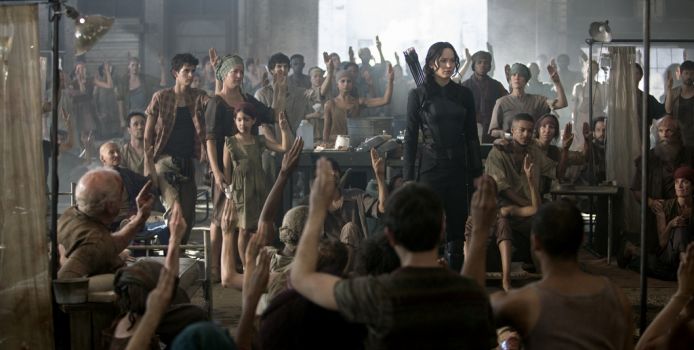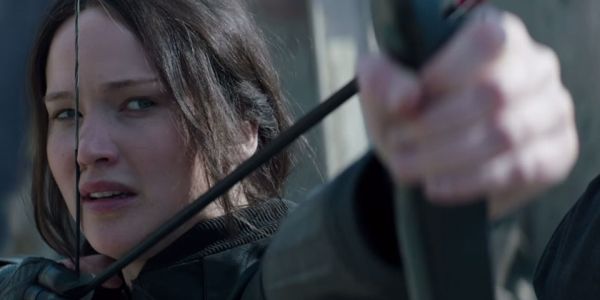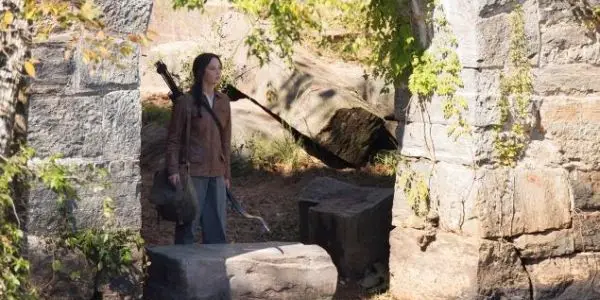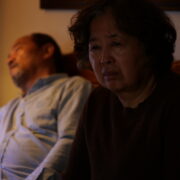THE HUNGER GAMES MOCKINGJAY PT. 1 Focuses on Worldbuilding

Alistair is a 25 year old writer based in Cambridge.…
As much as I love movies, I’m completely against the franchise bandwagon. Every time I hear about a movie I love having a successful opening weekend at the box office I get a sense of impending dread that they are going to ruin my memories of it with a plethora of inferior sequels. Even though I grew up on the Harry Potter and Lord of the Rings franchises, both the books and the films, I’m not feeling nostalgia so much as cynicism whenever a prequel is announced or released.
The Hunger Games is notable for being the only blockbuster franchise where I actually care more with each subsequent film, as it expands its dystopian universe in a way that’s both thrilling to its young target audience as well as developing the social and political problems facing Panem in a way that’s rather satisfying. I haven’t read the books and don’t feel any nostalgia towards the previous entries of the franchise – I’m just eager to see how the world created develops onscreen. The (as it currently stands) trilogy can happily rank alongside the best and the bleakest dystopian futures the big screen has given us.
In The Hunger Games: Mockingjay Part I, Jennifer Lawrence returns as Katniss Everdeen, reintroduced waking up in a medical bay after some sort of breakdown following the closing events of Catching Fire. She has been taken to the secretive District 13 by Plutarch (Philip Seymour Hoffman in his penultimate performance) to be presented to the district’s president Coin (Julianne Moore) as the face of the revolution against the capitol. Reluctantly, Katniss accepts and finds herself becoming involved as the media-friendly face of a propaganda campaign that turns very badly, very quickly.
Mockingjay: A Character Study
Following the current unwelcome trend of unnecessarily splitting the franchise closer into two parts, as studio executives love the smell of money on a morning, Mockingjay has been criticized for being boring and for presumably leaving all the action until its forthcoming second half. The thing that I liked about the film was that it had the courage to step away from its central premise and not even feature the games. After all, we’ve seen the games twice now and any more would lead to audience fatigue. In fact, this helps the franchise overcome the major criticism facing it (that it’s nothing more than Battle Royale for pre-teens) by instead recreating itself as a character study that reinforces that it’s the effect the violence has on the characters and their universe that’s important, not the carnage created.

The sequences that stand out for me are whenever Plutarch and Coin, with the unwelcome help of resident drunk Haymitch (Woody Harrelson), try to shape Katniss’ media profile. Firstly, these sequences excel from a purely acting perspective – when you’ve assembled those four actors into a single scene no directorial effort is needed, all anybody needs to do is turn up and shout “action”!
In all seriousness, although I am bewildered by anybody calling this film boring, I can understand why these parts are likely to not be as equally embraced by the young adult audience.Currently, I’m in the middle of writing a 2,500 word essay where I have to analyse a PR campaign, its effect on the media and how it was received by the public. Every single one of these sequences, that develop into Katniss and Peeta (Josh Hutcherson) having a relationship breakdown over rival media coverage, outline the basic principles of PR in a way so entertaining it’s making me want to go back and finish that essay as soon as I’ve finished writing here.

Every single detail in these sequences, namely the micro-managing of a celebrities personality in order for the public to like them, has been dealt with in pop culture before. Yet by introducing it in this most mainstream of film franchises, it’s giving younger audiences basic lessons in the relationships between politics and the media in a way that doesn’t feel remotely like a lesson. In fact, this entire story arc advances the plot; say what you want about the Hunger Games movies, but you have to admit they actually use these political parables to advance the plot instead of just using them as nothing more than subtext, as you will find in the majority of films trying their hardest to engage more than just the popcorn audience.
Jennifer Lawrence dials the drama up to eleven – not a good thing
This doesn’t mean the film is action-free, but it does represent the most unwelcome moments. Whereas Catching Fire, director Francis Lawrence’s debut entry for the franchise, managed to balance the character beats and the action exquisitely, he doesn’t repeat the same trick here. As Katniss and Co. are spending most of their time holed away inside the tribute centre or travelling to different districts, a poor directorial decision has been made to include action sequences of little consequence that solely involve extras.
Whenever Katniss and the film crew led by Game of Thrones’ Natalie Dormer are in the midst of the action, the implications her presence has on everyone near are sorely felt. Whenever she’s not present, the violence has little ramification to the plot development; for a franchise based on the horrors that violence can trigger, having violent scenes that lead nowhere is unquestionably problematic to the pacifistic morals of the entire story.

Paradoxically, my other main problem with the film is Katniss herself – or rather, Jennifer Lawrence’s portrayal of her. In the first two films she underplayed the role as a hardened feminist icon, more bothered about survival than any of that mopey lovey-dovey business. Now, with Peeta captured by the capitol, Lawrence’s performance mainly consists of histrionic crying. All of Lawrence’s earliest performances, such as Winter’s Bone, were defined by her subtlety. Since she landed an Oscar, she’s dialled everything up to eleven and all her performances are looking increasingly unrealistic as a result. Katniss is still one of the best characters in mainstream cinema – but as the films around her get better, she becomes far less interesting.
To conclude, part one of Mockingjay has left me eagerly anticipating the final installment, yet equally dreading it. As it currently stands, the things that work about the movies are the character developments and the socio-political implications of being a freedom fighter in a dystopian universe, not the battle sequences that come with it. With the final half likely to be action-oriented, I can’t help but hope the conclusion will be as equally restrained as the best moments here.
Have you seen Mockingjay? Has it left you eagerly anticipating the final installment, or has it bored you into a coma?
Does content like this matter to you?
Become a Member and support film journalism. Unlock access to all of Film Inquiry`s great articles. Join a community of like-minded readers who are passionate about cinema - get access to our private members Network, give back to independent filmmakers, and more.
Alistair is a 25 year old writer based in Cambridge. He has been writing about film since the start of 2014, and in addition to Film Inquiry, regularly contributes to Gay Essential and The Digital Fix, with additional bylines in Film Stories, the BFI and Vague Visages. Because of his work for Film Inquiry, he is a recognised member of GALECA, the Gay & Lesbian Entertainment Critics' Association.













